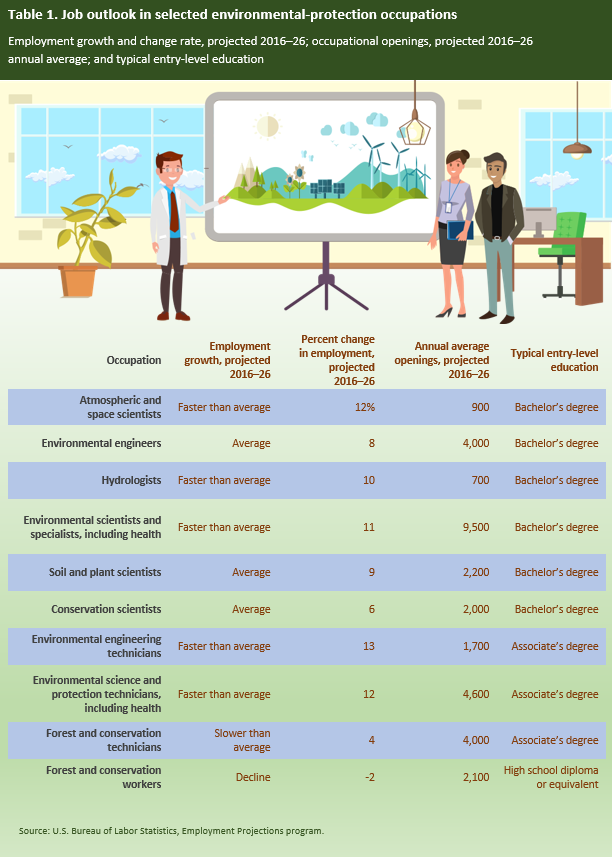Earning green by working green: Wages and outlook in careers protecting the planet
Elka Torpey | April 2019
What’s good for the earth may be good for your earnings. Wages in many occupations related to environmental protection were well above the $38,640 median annual wage for all occupations in 2018, according to the U.S. Bureau of Labor Statistics (BLS).
Chart 1 shows 10 occupations that involve monitoring the environment and preserving natural resources. In some of these occupations, wages were more than twice the overall median. Atmospheric and space scientists had the highest wage of the occupations in the chart, $94,110.
Chart 1. Wages and employment in selected environmental-protection occupations, 2018
| Occupation |
Median annual wage, 2018 |
Employment, 2018 |
|
Atmospheric and space scientists
|
$94,110 |
9,310 |
|
Environmental engineers
|
87,620 |
53,070 |
|
Hydrologists
|
79,370 |
6,290 |
|
Environmental scientists and specialists, including health
|
71,130 |
80,480 |
|
Soil and plant scientists
|
63,950 |
15,010 |
|
Conservation scientists
|
61,310 |
22,200 |
|
Environmental engineering technicians
|
50,560 |
17,310 |
|
Environmental science and protection technicians, including health
|
46,170 |
32,600 |
|
Forest and conservation technicians
|
37,180 |
30,220 |
|
Forest and conservation workers
|
27,460 |
7,510 |
Rapid employment growth is expected over the 2016–26 projections decade in half of these eco-friendly occupations. (See table 1.) But together, the occupations shown in the chart account for less than 1 percent of all jobs in the economy. Environmental scientists and specialists have the most employment; hydrologists have the least. It’s therefore important to consider the average number of openings expected annually.

Table 1. Job outlook in selected environmental-protection occupations
Employment growth and change rate, projected 2016–26; occupational openings, projected 2016–26 annual average; and typical entry-level education
| Occupation |
Employment growth, projected, 2016–26 |
Percent change in employment, projected 2016–26 |
Annual average openings, projected 2016–26 |
Typical entry-level education |
|
Atmospheric and space scientists
|
Faster than average |
12% |
900 |
Bachelor's degree |
|
Environmental engineers
|
Average |
8 |
4,000 |
Bachelor's degree |
|
Hydrologists
|
Faster than average |
10 |
700 |
Bachelor's degree |
|
Environmental scientists and specialists, including health
|
Faster than average |
11 |
9,500 |
Bachelor's degree |
|
Soil and plant scientists
|
Average |
9 |
2,200 |
Bachelor's degree |
|
Conservation scientists
|
Average |
6 |
2,000 |
Bachelor's degree |
|
Environmental engineering technicians
|
Faster than average |
13 |
1,700 |
Associate's degree |
|
Environmental science and protection technicians, including health
|
Faster than average |
12 |
4,600 |
Associate's degree |
|
Forest and conservation technicians
|
Slower than average |
4 |
4,000 |
Associate's degree |
|
Forest and conservation workers
|
Decline |
-2 |
2,100 |
High school diploma or equivalent |
For example, the occupation of environmental engineering technicians is projected to have the fastest employment growth of all occupations in the table; however, the 1,700 openings projected annually, on average, for that occupation are fewer than half of the 4,000 openings projected for the slower growing forest and conservation technicians.
All of these environmental-protection occupations, except forest and conservation workers, typically require an associate’s or a bachelor’s degree to enter. Learn more about these and other occupations in the Occupational Outlook Handbook.
Elka Torpey is an economist in the Office of Occupational Statistics and Employment Projections, BLS. She can be reached at torpey.elka@bls.gov.
Suggested citation:
Elka Torpey, "Earning green by working green: Wages and outlook in careers protecting the planet,"
Career Outlook,
U.S. Bureau of Labor Statistics,
April 2019.
 United States Department of Labor
United States Department of Labor